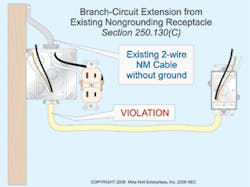Q. I am doing a remodel on a very old home with 2-wire NM cable and non-grounding type receptacles. We want to add receptacles, but aren't sure how to ground them. What are my options?
A. Let's start by talking about replacing existing receptacles. Where a non-grounding receptacle is replaced with a grounding-type receptacle from an outlet box that doesn't contain an equipment grounding conductor, the grounding contacts of the receptacle must be connected to one of the following [250.130(C)]:
- Grounding electrode system [250.50]
- (Grounding electrode conductor
- (Panelboard equipment grounding terminal
- (Service neutral conductor
It's worth noting that a grounding-type receptacle can replace a non-grounding type receptacle, without having the grounding terminal connected to an equipment grounding conductor, if the receptacle is GFCI protected and marked in accordance with 406.3(D)(3).
When adding new receptacles, you can't take an existing 2-wire circuit and extend it to add any new receptacle outlets [250.130(C)], as shown in the Figure. Any new receptacles added to the building will need to be connected to a circuit that includes an equipment grounding conductor, which complies with 250.118.
Q. Do I need to ground/bond to the metal fire sprinkler piping systems?
A. The metal water piping system must be bonded as required in 250.104(A)(1), (A)(2), or (A)(3). The bonding jumper must be copper where within 18 in. of earth [250.64(A)], securely fastened to the surface on which it's mounted [250.64(B)], and adequately protected if exposed to physical damage [250.64(B)]. In addition, all points of attachment must be accessible [250.104(A)].
In response to a Code change proposal in 2008, the technical committee stated in its NEC Report on Proposals, "A metallic fire sprinkler piping system is a metal water piping system that is covered by Section 250.104(A). Section 250.104(A) does not differentiate or exclude between the various types of metal water piping systems that might be present in a building or structure." Refer to proposal 5-240 Log #1448 for more information.
Q. I recently failed an inspection for having a 15A GFCI receptacle on a 20A branch circuit in the master bath. Is the inspector correct?
A. Assuming the receptacle was not of the singular type, your inspector is incorrect. Where connected to a branch circuit that supplies two or more receptacles, receptacles must have an ampere rating in accordance with the values listed in Table 210.21(B)(3), which allows for a duplex 15A receptacle on a 20A branch circuit.
Q. I have been using SER cable for nearly 20 years. I am now being told that I can't use it because it's not in the Code. I have searched for the term "SER" in the Code and can't find it either. What is the deal?
A. Great question! You won't find the term "SER" in the Code. SER cable is actually SE cable with an insulated neutral, resulting in three insulated conductors with an uninsulated equipment grounding conductor. SER cable is round (hence, the acronym), while 2-wire SE cable is flat. SER is covered by Art. 338.
About the Author

Mike Holt
Mike Holt is the owner of Mike Holt Enterprises (www.MikeHolt.com), one of the largest electrical publishers in the United States. He earned a master's degree in the Business Administration Program (MBA) from the University of Miami. He earned his reputation as a National Electrical Code (NEC) expert by working his way up through the electrical trade. Formally a construction editor for two different trade publications, Mike started his career as an apprentice electrician and eventually became a master electrician, an electrical inspector, a contractor, and an educator. Mike has taught more than 1,000 classes on 30 different electrical-related subjects — ranging from alarm installations to exam preparation and voltage drop calculations. He continues to produce seminars, videos, books, and online training for the trade as well as contribute monthly Code content to EC&M magazine.
